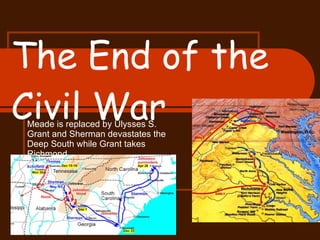End of the Civil War Powerpoint
•Download as PPT, PDF•
1 like•4,295 views
Report
Share
Report
Share

Recommended
Recommended
More Related Content
What's hot
What's hot (20)
Viewers also liked
Viewers also liked (20)
Similar to End of the Civil War Powerpoint
Similar to End of the Civil War Powerpoint (20)
Social Studies Ch 3 lessons 1 and 2 The Civil War Begins and The Union Victo...

Social Studies Ch 3 lessons 1 and 2 The Civil War Begins and The Union Victo...
Technology Connections Final Project Markus Norman

Technology Connections Final Project Markus Norman
More from Thomas Melhorn
More from Thomas Melhorn (19)
Civil War War Between the States What would have caused this destruction?

Civil War War Between the States What would have caused this destruction?
Chapter 17 Daily Life in the Gilded Age Powerpoint

Chapter 17 Daily Life in the Gilded Age Powerpoint
Beginning of the Civil War Powerpoint U.S. History i

Beginning of the Civil War Powerpoint U.S. History i
Recently uploaded
YOUVE GOT EMAIL_FINALS_EL_DORADO_2024.pptx

YOUVE GOT EMAIL_FINALS_EL_DORADO_2024.pptxConquiztadors- the Quiz Society of Sri Venkateswara College
USPS® Forced Meter Migration - How to Know if Your Postage Meter Will Soon be...

USPS® Forced Meter Migration - How to Know if Your Postage Meter Will Soon be...Postal Advocate Inc.
Recently uploaded (20)
4.18.24 Movement Legacies, Reflection, and Review.pptx

4.18.24 Movement Legacies, Reflection, and Review.pptx
ENG 5 Q4 WEEk 1 DAY 1 Restate sentences heard in one’s own words. Use appropr...

ENG 5 Q4 WEEk 1 DAY 1 Restate sentences heard in one’s own words. Use appropr...
Influencing policy (training slides from Fast Track Impact)

Influencing policy (training slides from Fast Track Impact)
USPS® Forced Meter Migration - How to Know if Your Postage Meter Will Soon be...

USPS® Forced Meter Migration - How to Know if Your Postage Meter Will Soon be...
AUDIENCE THEORY -CULTIVATION THEORY - GERBNER.pptx

AUDIENCE THEORY -CULTIVATION THEORY - GERBNER.pptx
Choosing the Right CBSE School A Comprehensive Guide for Parents

Choosing the Right CBSE School A Comprehensive Guide for Parents
End of the Civil War Powerpoint
- 1. The End of the Civil War Meade is replaced by Ulysses S. Grant and Sherman devastates the Deep South while Grant takes Richmond
- 18. William Tecumseh Sherman- The taking of Atlanta and the March to the Sea May 9 through December 22, 1864
- 19. Two Portions of the March
- 26. The Burning of Atlanta
- 27. The Concurrent Destruction of 40,000 strong Army of the Tennessee under John Bell Hood
- 28. Battle of Cold Harbor and the Siege of Petersburg, along with The Crater Battle of Cold Harbor- June 1-3, 1864 Siege of Petersburg The Siege of Petersburg- June 15, 1864 through March 25, 1865
- 34. Grant’s Railroad destruction operations after the loss at Cold Harbor
- 36. Confederate Defenses at Petersburg
- 37. Union defenses on the outskirts of the Confederate trenches
- 41. Appomattox Courthouse meeting- April 9, 1865
- 42. REVIEW TIME!